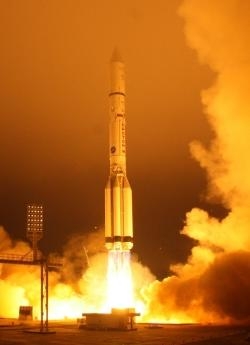Tue, Dec 10, 2013
First Global XpressA Satellite Launch; 7th ILS Proton Launch Of 2013
An International Launch Services (ILS) Proton Breeze M successfully placed the Inmarsat-5 F1 (I-5 F1) satellite into a super-synchronous (geo-stationary) transfer orbit (SSTO) Sunday. The spacecraft was launched for Inmarsat. I-5 F1 is the first of three Inmarsat next-generation Global Xpress satellites scheduled to launch before the end of 2014. This marks the seventh launch of the year and the third SSTO mission for ILS, a leader in providing mission integration and launch services to the global commercial satellite industry.

The Proton launch vehicle, carrying the I-5 F1 satellite, lifted off from Pad 39 at the Baikonur Cosmodrome Sunday at 1812 local time (1212 GMT). The SSTO mission utilized a 5-burn Breeze M mission design to advance the orbital unit first to a circular parking orbit, then to an intermediate orbit, followed by a transfer orbit, and finally to a 65,000 km-apogee super-synchronous transfer orbit. After a 15-hour, 31-minute mission, the satellite was placed into the target orbit by the Proton launcher. SSTO missions provide increased heavy-lift performance over GTO mission designs, allowing our customers the capability to maximize spacecraft operational lifetime.
The satellite was manufactured by Boeing Satellite Systems International and built on the 702HP platform. Weighing over 6 metric tons at lift-off, the I-5 F1 satellite has 89 Ka-band fixed beams and 6 steerable ones. I-5 F1 is designed to generate approximately 15 kilowatts of power at the start of service and approximately 13.8 kilowatts at the end of its 15-year design life. To generate such high power, the spacecraft's two solar wings employ five panels of ultra-triple-junction solar cells.
Global Xpress will be the first globally available high-speed broadband Ka-band network. It will offer the unique combination of global coverage from a single operator, consistent higher performance of up to 50Mbps, and the network reliability for which Inmarsat is renowned. Based on Ka-band technology, Global Xpress will consistently deliver higher performance through more compact terminals at a lower cost than existing VSAT services, making it accessible to many more users.
ILS President Phil Slack stated, “We are honored to share this momentous occasion with Inmarsat, true innovators in the satellite communications industry, with the first ILS Proton launch of three in the Global Xpress constellation. Today’s ILS Proton launch builds on a strong relationship between Inmarsat and ILS dating back to 2008 with the launch of an Inmarsat-4 satellite. We thank the teams who worked tirelessly on the successful launch of I-5 F1 and look forward to our upcoming missions with Inmarsat.”
“Global Xpress is the result of three years of planning and, together with a fourth Inmarsat-5 satellite we ordered recently from Boeing, represents an investment of $1.6 billion in our next generation of high bandwidth, high capacity, mobile broadband communications satellites,” said Rupert Pearce, CEO, Inmarsat. “Our Global Xpress constellation, which is on schedule to achieve full global coverage by the end of 2014, will ensure our satellite services fully support the current and future needs of our end-users across the world - whether on land, at sea or in the air. I wish to thank the teams at Inmarsat and Boeing for their hard work and ingenuity in bringing this highly innovative program to fruition. We also thank our experienced partners at ILS and Khrunichev for their dedication and assurance in ensuring this mission was successful. We look forward to our future ILS Proton launches next year.”
The I-5 F1 launch also marked the 392nd launch for Proton since its maiden flight in 1965 and the 84th ILS Proton Launch overall. This was also the 16th Boeing-built satellite launched on an ILS Proton and the 3rd Inmarsat satellite launched on Proton overall. The Proton M Breeze M vehicle is developed and built by Khrunichev Research and Production Space Center of Moscow, Russia’s premier space industry manufacturer and majority shareholder in ILS.
(Image provided by ILS)
More News
Airport Rotating Beacon A visual NAVAID operated at many airports. At civil airports, alternating white and green flashes indicate the location of the airport. At military airports>[...]
Aero Linx: Fly for the Culture Fly For the Culture, Inc. is a 501(c)(3) non-profit organization that serves young people interested in pursuing professions in the aviation industry>[...]
Klyde Is Having Some Issues Comprehending The Fed's Priorities FMI: www.klydemorris.com>[...]
Also: Viasat-uAvionix, UL94 Fuel Investigation, AF Materiel Command, NTSB Safety Alert Norges Luftsportforbund chose Aura Aero's little 2-seater in electric trim for their next gli>[...]
Also: EP Systems' Battery, Boeing SAF, Repeat TBM 960 Order, Japan Coast Guard H225 Buy Despite nearly 100 complaints totaling millions of dollars of potential fraud, combined with>[...]
 ANN's Daily Aero-Term (04.25.24): Airport Rotating Beacon
ANN's Daily Aero-Term (04.25.24): Airport Rotating Beacon ANN's Daily Aero-Linx (04.25.24)
ANN's Daily Aero-Linx (04.25.24) Klyde Morris (04.22.24)
Klyde Morris (04.22.24) Airborne 04.24.24: INTEGRAL E, Elixir USA, M700 RVSM
Airborne 04.24.24: INTEGRAL E, Elixir USA, M700 RVSM Airborne 04.22.24: Rotor X Worsens, Airport Fees 4 FNB?, USMC Drone Pilot
Airborne 04.22.24: Rotor X Worsens, Airport Fees 4 FNB?, USMC Drone Pilot



